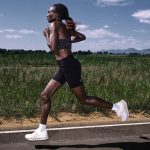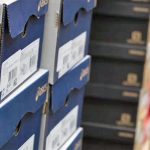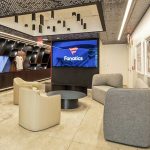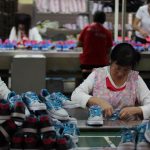At its first Investor Day since its IPO, On’s leadership team outlined investments in newer categories, including training, tennis, apparel, China, owned retail, and the continued momentum in running, which the company expects will drive its goal of doubling sales in three years. However, with brand awareness in the U.S. at just 9 percent, the business’s core priority is getting the word out.
Marc Maurer, co-CEO, On, commented at the event held at its headquarters in Zurich on Wednesday, about why the effort in raising brand awareness was among On’s four key growth drivers cited in the prospectus for its successful IPO completed in September 2021.
A recently conducted brand awareness survey showed the U.S., which On entered in 2013, ranked fifth in Unaided Brand Awareness among major countries the brand entered. The highest rate was found in On’s home country of Switzerland, at 47 percent, followed by Austria, 24 percent; Germany, 15 percent; and Japan, 12 percent. Brand awareness in the U.K. was 6 percent, although 10 percent in London. Brand awareness was 6 percent in France and 4 percent in Australia.
Maurer said all regions have shown significant improvement in awareness since the IPO. “We’re very much convinced that the work that we’re doing is paying off. On is significantly increasing brand awareness in all markets within local communities, but also on a larger scale,” said Maurer.
However, Maurer also noted that countries and cities where the brand has mainly focused are achieving over-proportional gains in brand awareness, citing significant gains in the U.S. and London, a city that the company has concentrated on in Europe. Maurer said, “We opened our Regent Street retail store in London, and we saw a significant uplift in the wholesale channel as well as in the e-com channel.”
At the same time, Maurer said its most recent brand awareness survey showed ample room to continue growing. He observed, “Switzerland still has 53 percent left to get to 100 percent, and all the other markets significantly lag behind Switzerland, so we feel there’s ample room for growth.”
Beyond brand awareness, however, On is also looking to expand its share with core runners as part of a long-term goal to become the world’s leading running shoe. In measuring its progress, On looked at its market share by seeing which shoes runners wear on prime running routes in major cities worldwide. For instance, recent findings show the brand is worn by just 15 percent of runners on major running routes in Miami and only 7 percent in New York City.
Maurer said one message it offers is, “We’re making progress. This was much, much lower at the IPO. Message number two: there’s still room for growth, which is amazing.”
Finally, On looked at whether the brand is “resonating within our core communities that we’re tackling beyond running. How are we building cultural relevance?” Towards that end, he noted that since the IPO, On’s Instagram, Tik Tok and other social channel followers have grown 94 percent.
Maurer said, “So we’re growing brand awareness. We’re growing in running. And we’re growing with our core communities, which I think tells us that on the brand side, we’re doing a pretty good work.”
Increasing share in running and brand awareness among its targeted communities is part of the first leg of three strategic growth pillars expected to drive On’s growth over the next three years.
As previously reported by SGB Media, the three pillars are:
- Elevate: On continues seeing a significant growth runway in its core areas. The growth pillar Elevate includes the strategic building blocks to further elevate its market share in running, its brand awareness among its communities and its performance credibility and sustainability impact.
- Expand: On is at the early stage of geographic expansion and sees potential to build its footprint. The growth pillar Expand includes the strategic building blocks to increase its premium multi-channel distribution, own retail presence and footprint in China.
- Establish: On is stepping into selected adjacencies while staying true to its philosophy of establishing credibility in performance. The growth pillar Establish includes the building blocks to establish its training community, light up tennis courts and establish full head-to-toe looks across all its verticals.
Martin Hoffmann, CFO and CO-CEO, said at the event that pursuing a multi-channel strategy was also seen as a key growth driver at the time of the IPO.
“Over the last two years, we have significantly extended our capabilities and our reach in all three channels,” said Hoffmann. “So, from On retail to e-com to wholesale. And we are super pleased that our DTC channel has been growing a little bit stronger than our wholesale channel despite the fact that two years ago, basically, we were in the middle of the pandemic. But for us, it’s really about the harmony of the channels. And so, it’s equally good for us to see that the growth is really driven by both channels at a similar pace.”
Hoffmann also noted that On’s multi-channel strategy’s success is reflected in consistent healthy growth across regions. He said, “So from the U.S. to the U.K., China, Japan, and many other markets, we have seen 70 to 100 percent growth in the last three years. And even markets where we started very early and have already reached a much higher brand awareness like Germany, where we’re driving 30 percent growth.”
On added 20 new markets since the IPO and converted five key markets to manage directly from distributors to help the brand drive “much more sales and profitability from those markets.”
Among channels, Hoffmann said e-commerce is “more powerful than ever,” with a new website launched at the start of the year that includes new capabilities supporting the display of products and a more personalized consumer experience.
In another sign of the brand’s momentum, members of the On online community have increased by nine times since the IPO. Hoffmann said, “This is a super important base for what we want to do in the future is really being much more specific and personalized in the journey going forward.”
Among channels, owned retail has seen the most rapid growth in recent years. At the time of the IPO, On had a U.S. flagship in New York City and seven stores in China. By the close of 2023, it expects to have 32 stores, including 22 in China.
Maurer said a significant learning for On in recent years has been that the brand can operate stores profitability. Maurer said,” On as a retail company works. Our retail stores work.”
A second learning is that owned retail drives “significant” brand momentum. Maurer said, “In almost all retail locations that we have opened so far, new doors have driven a visible uplift in our e-commerce and wholesale sales.”
Maurer also said On recognizes that retail must be “very important” in driving future growth because owned stores help introduce customers to new categories, such as apparel. In some stores, apparel exceeds 20 percent of the mix. The brand’s new store in Brooklyn’s Williamsburg section has an apparel share of 16 percent.
Maurer said, “All of this gives us a lot of confidence that On retail will play a very, very important role as part of our channels going forward. And we feel very much that over the last few years, we’ve actually built the foundation for this.”
Finally, Maurer noted that wholesale remains a “very, very important” channel for On and plays “an integral role in reaching new consumers.”
Maurer said, “We’ve expanded our wholesale presence while maintaining very much a premium focus, working with some of the best and largest retailers in the world. Being premium also means being very, very selective with whom we work and very prescriptive in how we roll outdoors and how we bring our assortments and products into the different doors. As a result, we have been able to reach a wider, more diverse range of runners and a younger audience than before who are very much aligned with the design and function of our products. The exciting part here is that with these key accounts, we are still at the very beginning of our journey. We expect to unlock significant growth in the years to come as we continue to fine-tune and expand our presence with our most important partners.”
On product, Maurer said On plans to “continue to dominate” in running while its entrance into the training “will significantly increase our addressable market.”
Overall, On has refocused its team around a vision of “building On as a true sportswear brand” supported by an increasing apparel share. He said, “The vision that will guide us going forward is that On aspires to be the most premium global sportswear brand, rooted in innovation, design, and sustainability.”
On’s three-year plan between 2023 through 2026 calls for:
- Doubling net sales between 2023 and 2026 to at least CHF3.55 billion, or approximately $3.95 billion at the average September 2023 conversion rate, reflecting a compounded annual growth rate (CAGR) of over 26 percent based on the outlook for the full fiscal year ending December 31, 2023;
- Exceeding 60 percent gross profit margin by 2026; and
- Deliver economies of scale, aiming to reach at least 18 percent adjusted EBITDA margin by 2026.
Over the last two years since the IPO, sales have grown at a CAGR (compound annual growth rate) of 65 percent, gross margins have improved 200 basis points, and adjusted EBITDA margin have gained 130 basis points. At the time of the IPO, On set a goal of reaching sales of CHF1.6 billion by 2024, and that goal will be reached in 2023
On reiterated its previously provided outlook for the full fiscal year ending December 31, 2023. This includes the expectations to reach CHF1.76 billion in net sales, or approximately $1.96 billion at the average September 2023 conversion rate, at least 58.5 percent gross profit margin and 15.0 percent adjusted EBITDA margin, respectively.
On also announced long-term targets to drive towards an apparel share of 10 percent-plus, owned retail share of 10 percent-plus and a China share of 10 percent-plus as part of overall sales.
Photo courtesy On
















